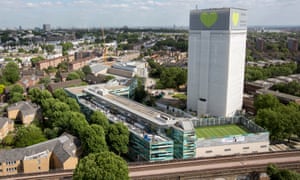Firefighters were unable to get water to the top floors of Grenfell Tower, where many of the victims of last year’s fire died, because the building was designed with firefighting infrastructure that would not support it, the public inquiry has heard.
Michael Dowden, a firefighter for 14 years and watch manager at North Kensington fire station, who was the first incident commander on the scene, said that above 50 metres the “water supply would be almost non-existent”.
Giving evidence for a second day, he described how the system of pipes running up the building to fight fires – known as dry risers – were unable to cope with the multi-storey fire he and his colleagues faced.
Throughout the night of 14 June 2017 the firefighters tackled the blaze, which spread rapidly from the kitchen of flat 16 on the fourth floor up to the 24th floor, eventually claiming 72 lives.
Dowden and his team plugged their hoses into two dry risers – one on the fourth floor and another on the third floor. This allowed them to blast 230 litres of water per minute with each hose, well within the fire brigade’s capability of providing 1,500 litres per minute to the fire.
The blaze quickly spread up and around the facades. Richard Millett QC, counsel to the inquiry, asked Dowden if he could have plugged hoses into every outlet to battle fires as they spread to other flats.
“That’s an almost impossible task … the dry riser is not designed to do that,” he said, adding that they had expected the building to be designed to limit the fire to the compartment where it began.
“We’d only really be fighting one floor. It would be extremely difficult and the further you go up the building the water pressure would lessen the output.”

Grenfell Tower was 67 metres high. The plug-in points for the dry risers were located in the flat lobbies,, which meant that running hoses up the stairs to tackle fires in flats required leaving fire doors ajar, which allowed smoke to penetrate the single evacuation staircase.
Dowden and Millett agreed that the general principle is that the dry riser should be in a protected stairwell.
Millett asked: “Did you take any steps to ensure that the obstruction was minimised?”
Dowden replied: “We can only work with what we’re given on the night in terms of what that building presents to us. We have to have a water supply. We have to put water on to that fire. We can only work with the facilities that are given to us at that moment in time.”
Earlier, Dowden admitted that when he arrived at the building he didn’t know it was covered in cladding, which experts to the inquiry have said spread the flames.
“I wasn’t aware it was cladding,” he said. “At that point I just thought it was the external part of Grenfell Tower.”
At the opening of his second day of evidence, Millett thanked Dowden, saying: “I want you to know that you’re doing a public service and we are extremely thankful to you for it.”
The inquiry continues.